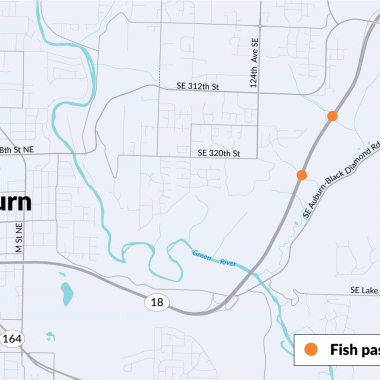Two unnamed tributaries cross under SR 18 through steel culverts, one flowing to Big Soos Creek and the other to Soosette Creek. Both culverts are not passable for fish because they are too high, creating a drop-off too high for fish to successfully jump up and preventing fish from traveling upstream. The steel culvert along Big Soos Creek is beginning to decay.
When replacing fish barriers, we must build structures and improve the stream so that fish can use it year-round at all stages of their life. That means during summer months when streams are usually lower, the stream must be usable by juveniles and adults. During winter, when water tends to run higher and faster, the stream must also have areas where fish can rest.
New fish passable structures
To replace the two existing culverts, WSDOT will build two new fish-passable structures. We'll also add woody vegetation, logs and other wood to this section of the unnamed tributaries to provide channel complexity and diversity, such as pools that provide refuge for young fish. These habitat elements enhance rearing and spawning habitat for fish. The improvements mean fish will have access to nearly one mile of habitat that was previously inaccessible.
This work is part of our fish passage program. Replacing the existing culverts and rebuilding the stream channels expands healthy fish habitat; an important step in restoring fish runs and increasing populations. This benefits commercial seafood operations and recreational fishers and provides more food for a declining orca population. Additionally, replacing these fish barriers helps us meet our obligation to remove barriers under the 2013 U.S. District Court injunction.
$135.91 million from Pre-Existing Funds (PEF), the Connecting Washington Account (CWA), Move Ahead Washington (MAW) and the State Motor Vehicle Account (MVA).
Unnamed Tributary to Big Soos Creek’s culvert crosses SR 18 and does not allow fish to pass.
Unnamed Tributary to Soosette Creek’s culvert crosses SR 18 and does not allow fish to pass.

